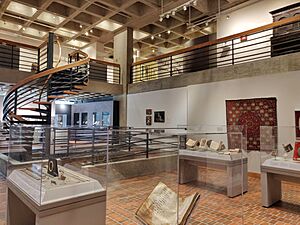Armenian Library and Museum of America facts for kids
| Established | 1971 to 1985 |
|---|---|
| Location | 65 Main Street, Watertown, Massachusetts |
| Type | Armenian |
| Visitors | 3,000 (annually) |
| Public transit access | MBTA |
The Armenian Museum of America (AMA) is in Watertown, Massachusetts, USA. It holds the biggest collection of Armenian items in North America.
Contents
Discovering the Museum's Past
How the Museum Started
In 1971, some talented Greater Boston Armenian-Americans noticed a problem. Many old Armenian books and special items brought by immigrants were getting lost or damaged. They decided to form the AMA to collect and protect these important pieces of history.
The museum started small in 1972. It had just two rented rooms in a church building in Belmont. Over time, it grew and moved to a larger basement space in a Watertown church. This new location opened to the public in 1985.
Finding a Permanent Home
In 1988, the AMA was able to buy its own building. It was an old bank building at 65 Main Street in Watertown. They fixed it up and dedicated it to Stephen P. Mugar and his wife, Marian G. Mugar.
When it first opened in 1988, it was called the Armenian Library and Museum of America. Later, in 2013, its name was officially changed to the Armenian Museum of America.
Exploring the Museum Building
The AMA's current home is in Watertown Square. It is a four-story building with a basement. The museum uses the basement, the first and second floors, and most of the third floor. Its library is on the fourth floor.
Other groups also have offices in the building. These include the Armenian International Women's Association ("AIWA") and Project SAVE Armenian Photographic Archives.
What You Can See Inside
The main exhibit area at AMA is called Bedoukian Hall. There are also several smaller galleries. You can find the Contemporary Art Gallery and the Terjenian-Thomas Art Gallery on the third floor.
The museum also has a special research library. There are studio spaces, offices, and rooms for meetings and classes. It even has a large auditorium that can seat 220 people. Don't forget to check out the gift shop!
Amazing Museum Collections
The Armenian Museum of America has one of the largest and most varied collections of Armenian items outside of Armenia. The museum often changes its exhibits. This means there's always something new to see when you visit! They usually have about 14 different exhibits each year.
The museum keeps many family treasures that people have donated. These items are a huge help for people studying Armenian history. They also help show and protect Armenian heritage. The AMA is the only independent Armenian museum that is not in Armenia itself. It gets most of its money from people who support it.
The museum's collections have over 20,000 items, including:
- Many different items from ancient times, including Urartian, religious, and ceramic objects. There are also medieval illuminated manuscripts.
- Over 5,000 old Armenian coins from different time periods.
- More than 3,000 textiles, which are woven fabrics. The AMA has one of the biggest Armenian textile collections outside of Armenia. A special textile expert, Susan Lind-Sinanian, helps care for them. These textiles are kept in a cool, dry place in the basement. They are also photographed and recorded there.
- 930 rare books that are very old and special.
- 170 Armenian rugs. Many of these rugs have Armenian writing on them. The collection includes rugs given by Arthur T. Gregorian in 1992.
The museum also keeps paintings by Dr. Jack Kevorkian. His parents were Armenian refugees.
The Mesrob Boyajian Library
The AMA is home to the Mesrob Boyajian Library. This library has over 26,000 books. They cover many different Armenian topics. The oldest book is the Garabed Gospel from the year 1207 AD.
The library has one of the largest collections of important books about oriental rugs. It also has a very big collection of books about the Armenian genocide. This collection is always growing. You can also find many Armenian magazines and newspapers here.
Herbert Offen Oriental Carpet Research Collection
The library also holds the Herbert Offen Oriental Carpet Research Library Collection. This is one of the biggest collections of books about oriental carpets in the United States. The Offen Family gave 2,500 books from the Herbert Offen Collection. They also provide money to buy more books about rugs and carpets, both new and old.
These 2,500 books cover many topics beyond just different types of oriental rugs. They include how collecting rugs affects society, what symbols and ideas rugs represent, how to care for them, and how they are sold. They also cover how rugs are made, how they were used in history, and other types of fabric art related to rugs.
Oral History Collection
In the early 1970s, the AMA started a big project. They interviewed people who survived the Armenian genocide. Most of these people are no longer alive today. The museum has made these recordings digital and cleaned up the sound.
The AMA's collection has over 1,400 hours of recorded stories. These stories are a great resource for researchers and students.



